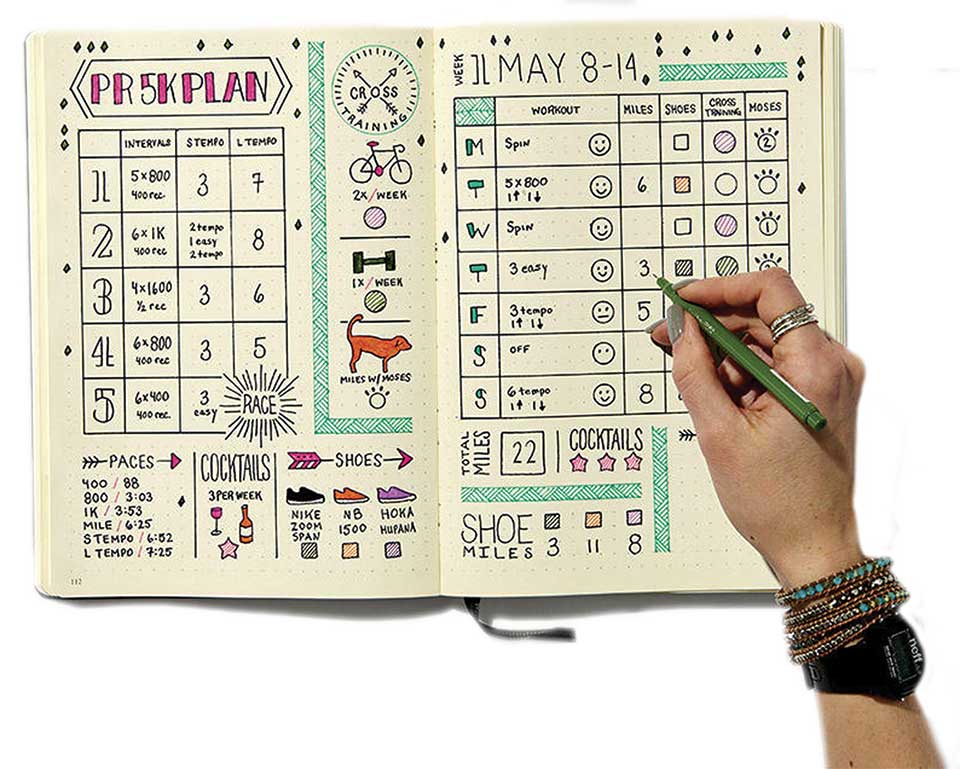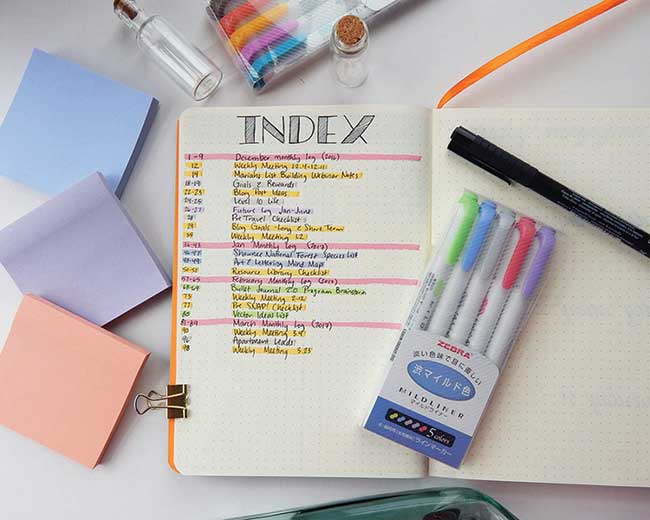
OR

The things we have done, the things we need to do, the things we aspire to do – there is a lot of things we have to keep a track of. Granted that there are a lot of apps to do that but lists often get lost in tabs and a small phone screen sometimes just doesn’t cut it when you want everything laid out in front of you. If you need a system flexible enough to keep track of whatever you throw at it and fast enough that it wouldn’t get in the way, the easiest solution would definitely be to maintain a bullet journal. This analogue system to keep a track of the past, organize the present, and plan the future is a sure shot way of easily managing your life.
Getting started
Grab a notebook of your choice. It can be of any size and shape but if you like to take your journal with you, then it would be much more practical to pick a small notebook that you can easily tuck in your purse.
To get started, flip to the first blank spread that will be your index page. Here, number every single page that you write on and add the title and the page number to your index as you go through your journal. This makes finding notes and ideas easier. Make sure to allocate two or more spreads for the index as a single page might not be enough to list out all the contents of your journal.
Now let’s set up the future log. Turn to the next spread and title both pages as future log. There are many different ways to create a future log. Here is a description of a simple six-month version. Measure the length of the page (or count the number of lines if you are using a lined journal) and divide that by three and section off your page into three parts. Using a ruler, draw a line in between the parts to section them properly. Do this to both the pages of your spread. Add a month to each part. When you’re done, number the pages and add future log to your index.
Turn to the next blank spread. This will be your monthly log. Title both pages with the month. The left page will be your monthly calendar. You can design the calendar any way you think will suit your requirements better. Boxed, horizontal, vertical or any other designs will work. The right page will be your monthly task list. Write down all the things you need to get done this month. Before each task draw a task bullet. Number the pages and add this to your index. The monthly log gives you a bird’s eye view of everything you need to get done this month and the time frame you have to get it done it in.
After the monthly log is the weekly log. Divide the next spread into eight equal parts, boxes, and label seven of those boxes according to the day, alongside the date. Here, you’ll write tasks you need to do every day of the week. Don’t include mundane or everyday tasks like showering, having dinner, etc. but include the important stuff and things that you have to do later on in the day but might forget. The last – or the first depending on which of the eight boxes you left out – is for tasks you need to do during this week but haven’t really specified a date or time for it like going to the salon or visiting a relative.
 Personalizing your journal
Personalizing your journal
Bullet journals are supposed to suit your requirements and priorities so style it keeping that in mind. If a horizontal layout does not work for you, try a vertical one. Maybe you are an incredibly artsy person and feel inspired if you see colorful pictures and drawings then you can add them to your bullet journal and make it a kind of an art journal too. Or maybe you are a very minimalistic person who likes to keep things simple and tidy. Then adopt an uncomplicated, basic, and monochromatic theme.
Bullet journals can also be a big collection of lists that you have floating around the house. You can create a new spread for each of those collections and list them out. You can create a list for virtually anything. You can create a list of every single place that you wish to travel this year. You can have lists of all the books, movies, and series that you’ve read, watched or plan to read, watch.
Maybe you’re a vegan and it’s really difficult for you to find places that serve vegan food. You can list out those places in your journal. You can create a list of birthdays of people close to you. Any kind of collection that you want, you can list it out and all of those lists will be in a single notebook instead of being scattered in 10 different notebooks. Just don’t forget to number the pages and note it in the index page.
You can customize your bullet journal to function as your school or work journal too. If you’re a student, you can carefully plan out your entire semester in your journal. You can do similar thing at work too. Create spreads for any project that you have to work and note down important things there or start planning for your next project. Keep a list of ideas for future projects as well. Bullet journal can also be your best friend if you work from home. They help you plan out your work schedule and deadlines, list out all the things you need to do and keep you on top of your game without giving into procrastination.
A very important advice for bullet journal setups would be to experiment and eliminate. Try out new layouts and themes and even collections and spreads. If something is not working for you, cut that out. Bullet journal is supposed to make you more productive and help you manage your time so don’t get stuck in a system that doesn’t work for you. You don’t have to copy someone else’s designs and ideas for your bullet journal because that particular design or idea is supposed help them organize their life better. There is no guarantee that the same system will work for you. Instead get ideas from a bunch of places and incorporate those alongside your own ideas and create something that makes you function at your best.
You May Like This

Indian national killed in shooting
BUTWAL, March 27: An Indian national has been shot dead in Butwal on Wednesday evening. An unidentified group shot Feroz... Read More...

Unidentified group fires bullet injuring one in Dhanusha
DHANUSHA, Sept 4: A man has been injured when an unidentified group fired a bullet on Monday night at Dhanusha. Read More...

China to speed up bullet trains in September: state media
SHANGHAI, July 27: China plans to raise the speed of its bullet trains back up to 350 kph (217 mph), state... Read More...




Just In
- Govt receives 1,658 proposals for startup loans; Minimum of 50 points required for eligibility
- Unified Socialist leader Sodari appointed Sudurpaschim CM
- One Nepali dies in UAE flood
- Madhesh Province CM Yadav expands cabinet
- 12-hour OPD service at Damauli Hospital from Thursday
- Lawmaker Dr Sharma provides Rs 2 million to children's hospital
- BFIs' lending to private sector increases by only 4.3 percent to Rs 5.087 trillion in first eight months of current FY
- NEPSE nosedives 19.56 points; daily turnover falls to Rs 2.09 billion















Leave A Comment